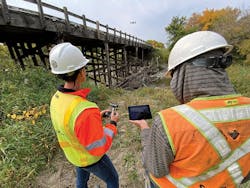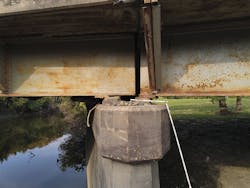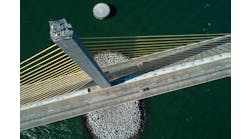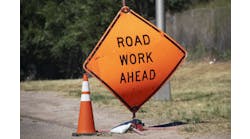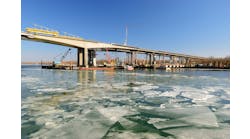New bridge inspection techniques increase speed, efficiency, and safety, but how do you choose the right ones for the job?
By: Michael Marshall
The technological advancements that we can now leverage across our architectural and engineering work—and bridge inspection specifically—is nothing short of astounding.
In the world of bridge inspection, we can now use drones and other technology to increase safety, improve data collection, and reduce delays to motorists. But just because we can, does that mean we should? Does every drone deployment result in cost savings and efficiency? And how do we reap the benefits of these new technologies while maintaining budgets? What follows are some key considerations that can and should affect decision making.
Bridge Structure
The first question to ask is whether drones and other technology can make a bridge inspection more efficient or offer new insights for asset management. Will conventional inspection procedures give us the necessary information at a similar cost and efficiency?
This will come down, in large part, to the bridge’s structure type and condition. For example, fracture-critical structures require hands-on access, not to mention the fact that deficiencies may not be visible using drones in similar steel details. Cracks in concrete are quite often more noticeable. For steel structures, however, key defects may be on the scale of less than an inch in size and located in hard-to-reach areas. Relying on drones to find these defects may overlook critical parts of the structure. On the flip side, drones may aid in identifying large-scale deficiencies such as corrosion or impacted areas, which are key areas of interest.
Concrete structures are well-suited for drone inspections, as key deficiencies are more visible and easily accessible. Drones for concrete bridges may help in providing an overall inspection model or hone in on defects not visible from the ground. Additional attachments such as infrared cameras may allow for detection of subsurface defects. Specialized defect recognition software to detect, size, and categorize cracking and spalling in concrete has come a long way in recent years. In general, drone use provides the most benefit to concrete structures in areas where conventional methods do not provide safe access.
Bridge Complexity and Site
Beyond the bridge structure, it is important to consider its complexity, size, and setting. Is there a benefit to sending a drone on a 50-ft single-span concrete frame, adding time and complexity to what is otherwise a routine, efficient procedure? Perhaps not. But on larger structures, drone inspections may be accomplished in a fraction of the time, and with fewer inspectors needed on the ground.
For example, a recent inspection of the concrete-steel Mike O’Callaghan–Pat Tillman Memorial Bridge on the border of Nevada and Arizona, utilized drones and created a significant cost savings for the client. By deploying drones, the inspection team completed views of bridge components that would have otherwise required additional time for manual rope access and experienced bridge inspection engineers.
The inspection team now utilizes drones on alternating inspection cycles for this bridge to reduce staff costs while facilitating an alternative view of the structure. Drone use also provides inspectors key points of interest and concern to focus on using conventional techniques. Such points of interest and concern were encountered on a steel girder structure in North Dakota, where the bearing pad was not easily accessible using conventional methods. The drone was able to easily capture key areas of interest and identify a bearing which may require closer inspection. This allowed the inspection team to focus time and resources on the specific area in question, rather than squandering that time on other, less important aspects.
From a site perspective, it is important to consider whether there is a launch point for the drone that is free of vehicles and pedestrians. Will the drone provide safer access to the bridge element to be evaluated than sending a bridge inspector?
Traffic is a common site obstacle to drone inspections. Current regulations and safety procedures prohibit or place restrictions on flying drones over live traffic, taking away access points to highway and interchange structures.
On the flip side, drones offer a safer alternative to sending an inspector in snow and icy weather, or areas with harsh terrain, steep slopes, loose riprap, and so forth. Rain and heavy winds may, of course, keep drones grounded, however.
Data and Technology
Finally, it is important to consider the digital output that will result from drone inspections.
Still photos from the drone are useful, but by stitching them together into a usable model, the digital twin of the bridge can be shared with clients and allows for inspectors to view any angle of the structure or bridge element in virtual or augmented reality.
Above all, developing a data governance framework and roadmap is an important fundamental approach, and should be integrated during early project planning activities to ensure data is properly organized, managed, described, integrated, and communicated. Early identification of risks, such as data gaps and inconsistencies, will help to apply mitigation measures and monitor potential risk exposure. It also encourages collaboration around digital innovation at all levels of the project.
The fact is, data is often managed ad-hoc or in duplicate, using personal computers, network file sharing, removable storage media, or cloud environments. Without a plan for managing the location and metadata for each file taken, the time savings offered by drone inspections may quickly be eclipsed by post-inspection administrative work.
Successful Use of New Technology
In the end, how do we take advantage of technology in the field of bridge asset management and inspection?
- Have a plan in place. Where will the drone be most effective and what is the end goal for the drone? Is it something that an inspector could not accomplish?
- How will this be used in future asset management? For overall structure modeling, specific defect tracking, or maybe gaining access to specific locations?
- Understand the end documentation goal. How will files be organized and post-processed? Do clients want to see or use the digital twin model for asset management, rehabilitation, or new design purposes?
- Ensure the bridge and site are both put to consideration. Will it be possible for the drone to obtain the data inspectors and engineers need given potential site constraints such as traffic or weather?
Overall, drone use may be a beneficial tool for bridge inspection with appropriate planning. As technology continues to develop, so will our procedures pertaining to bridge inspection. As the poet said, the readiness is all.
About The Author: Marshall is a bridge engineer in Stantec’s Denver office.
